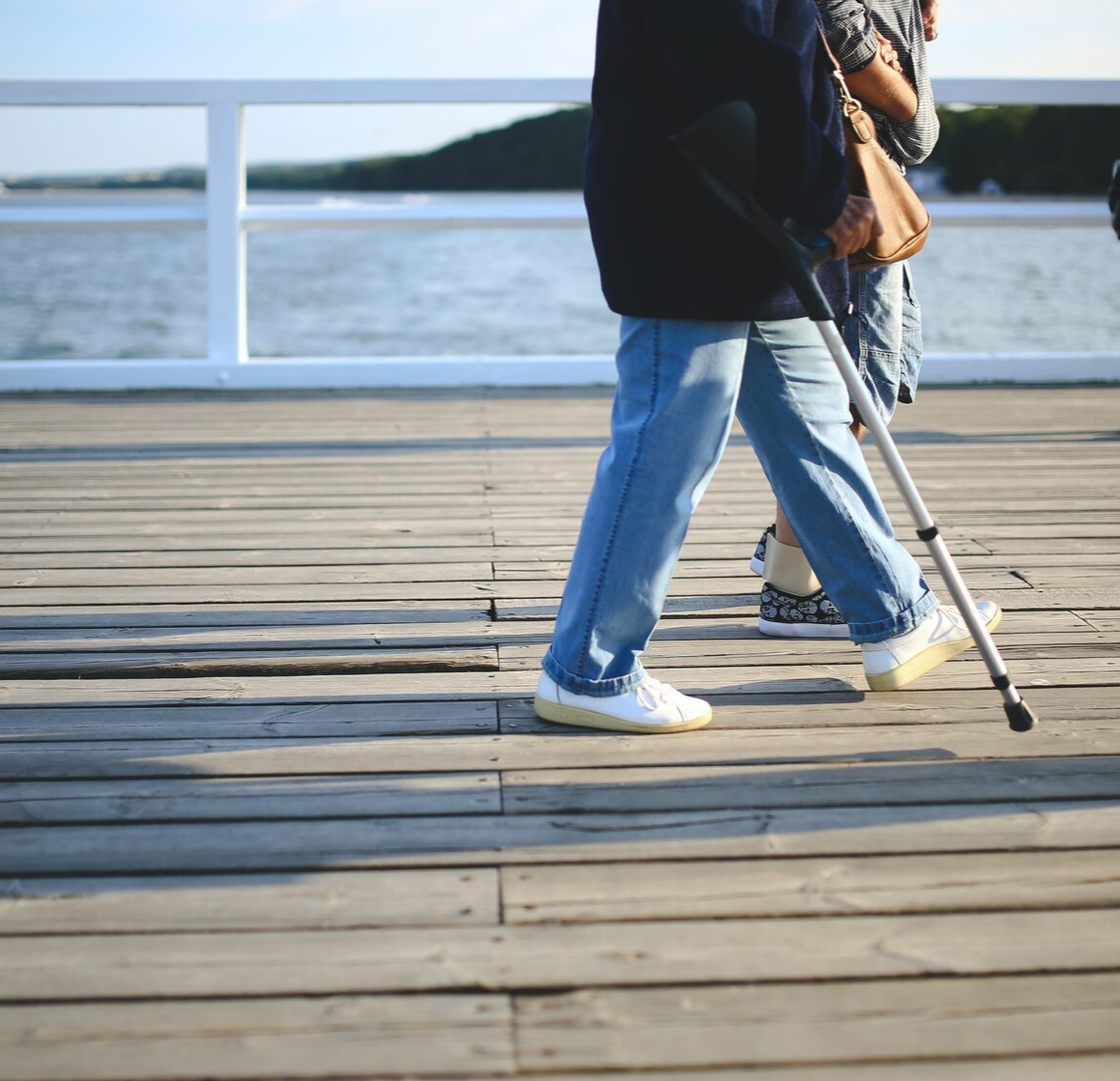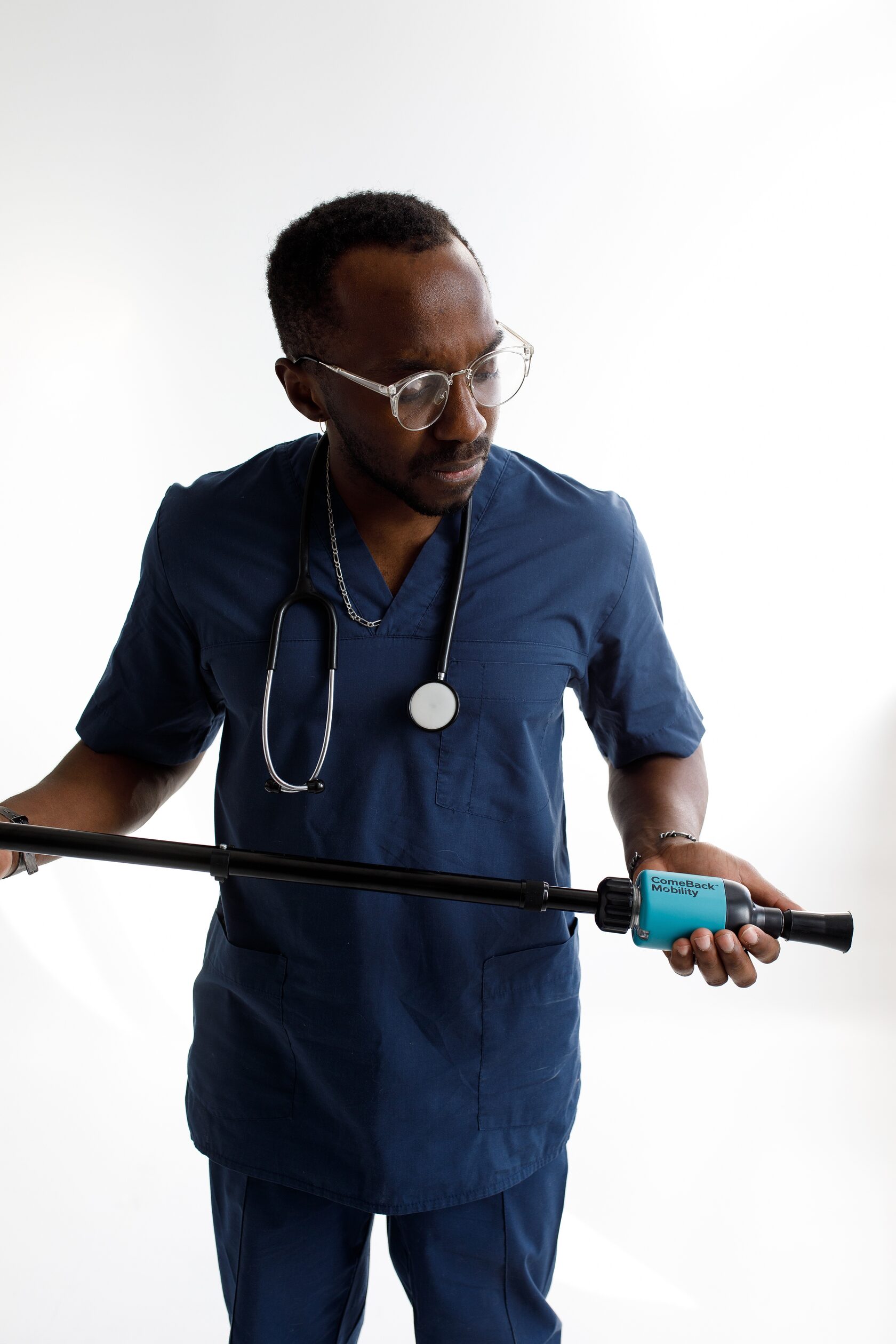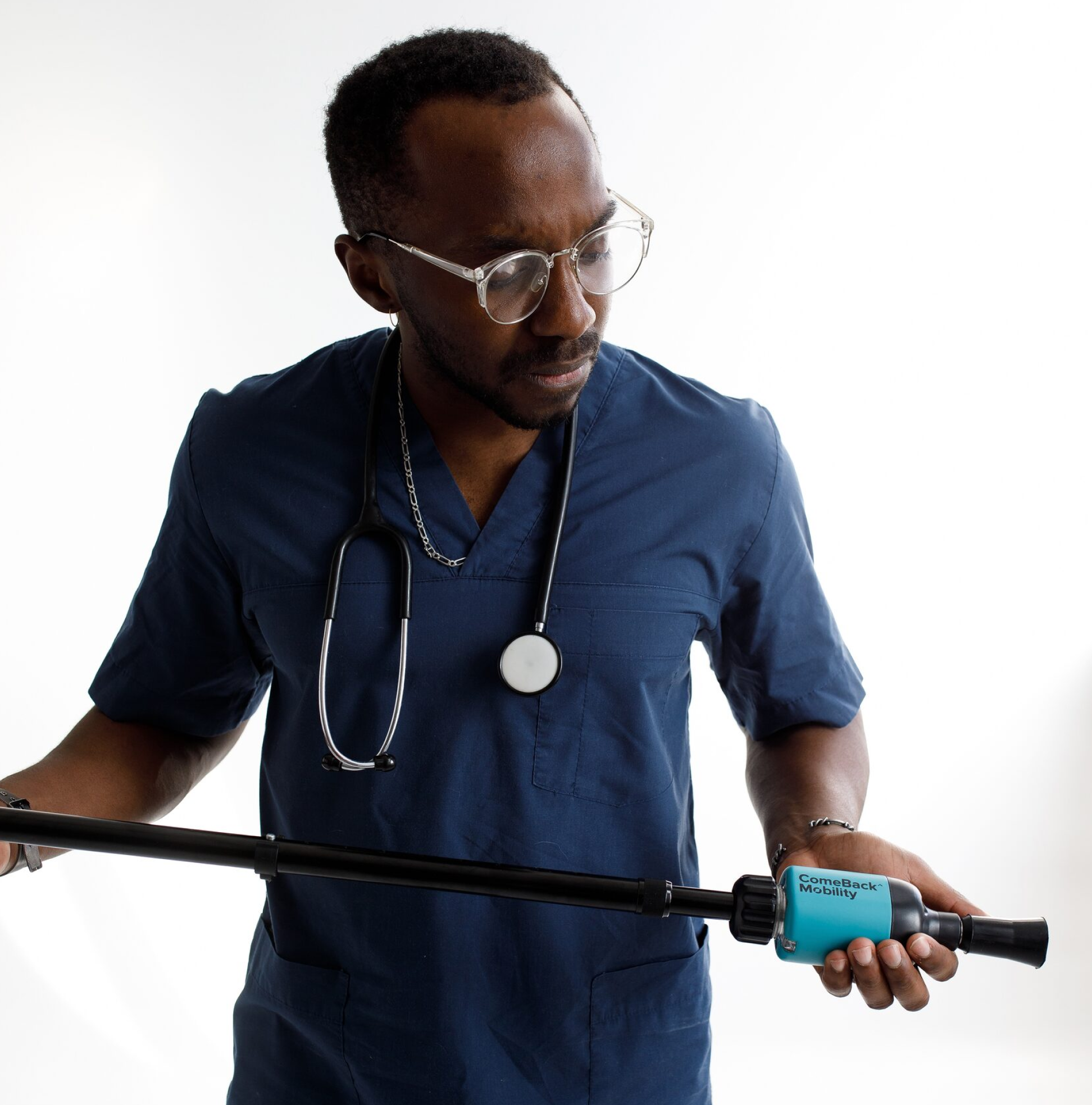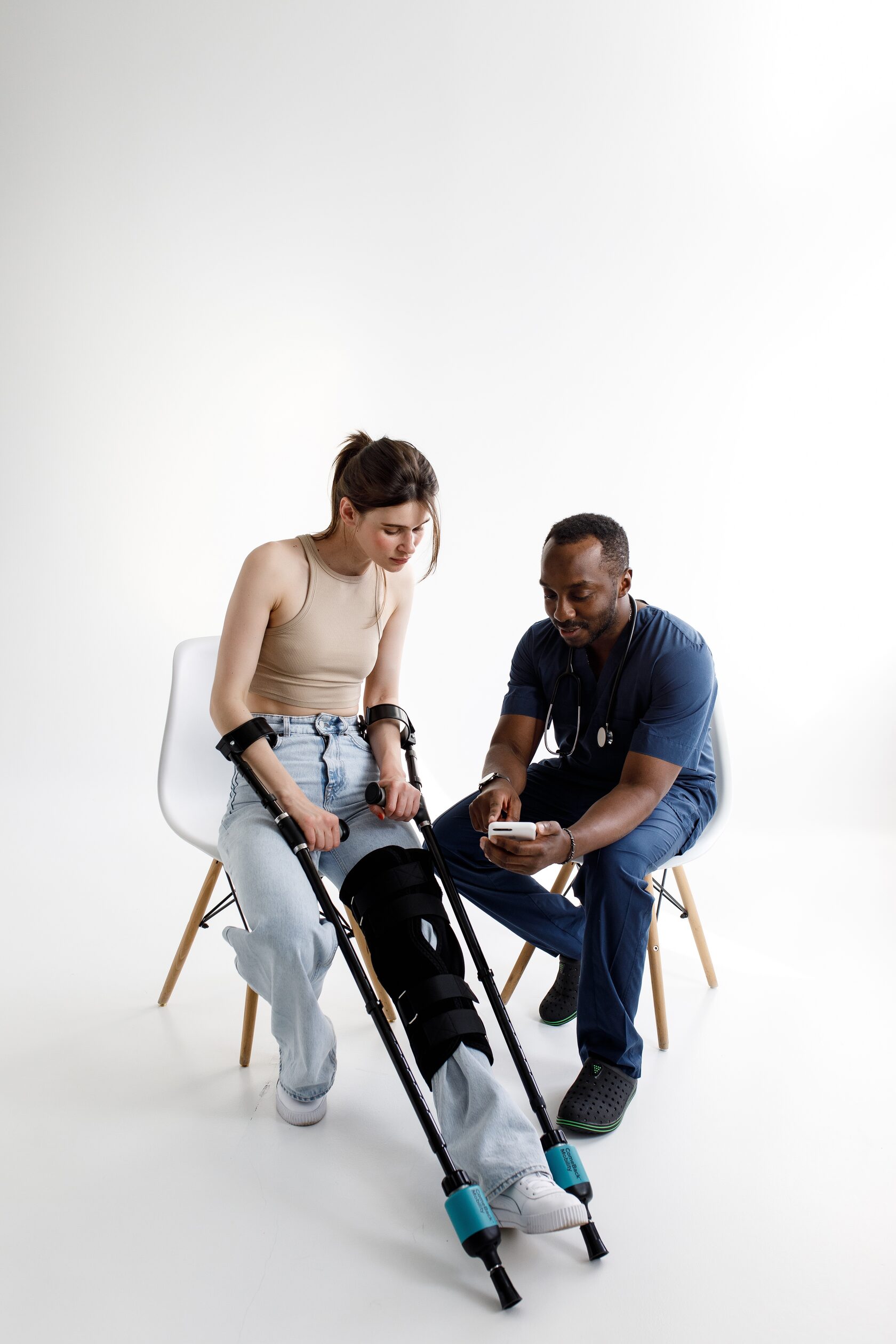Once you come home from the hospital or the doctor’s office, the real life of a patient begins. You must maneuver your home and environment without the help of nurses and other healthcare professionals. Standing in your home, many questions come to you. Here is a cheat sheet of the basics to keep you safe.
HOW TO ADJUST CRUTCHES
You need to stand still with your shoes on – preferably shoes without heels and a nonskid sole
Your arms are stretched along the side of your body and relaxed
In this position, the top of the crutches should be two inches away from your armpits, or two to three fingers width
The hand grips should be on level with your wrist. Holding the hand grips, you should keep your elbows slightly bent about 30 degrees. This arm positioning ensures that you use your upper shoulder muscles for using crutches versus hyperextending your elbows and wrists for support[2]
Using Crutches at Home in Different Situations
Walking





To begin with, the crutches are held by your arms and alongside your body. You stand in good posture and avoid hanging on the crutch pad.
Placing full weight through your armpit risks injuring a major nerve found in your armpit. While walking, you move your crutches six inches in front of you. Then, you move your injured leg forward placing as much load as you are allowed per your rehabilitation stage. Finally, you move your healthy leg forward. If you are on a non-weight-bearing restriction, then you move your crutches forward six inches and hop in line to them with your healthy leg.

Placing full weight through your armpit risks injuring a major nerve found in your armpit. While walking, you move your crutches six inches in front of you. Then, you move your injured leg forward placing as much load as you are allowed per your rehabilitation stage. Finally, you move your healthy leg forward. If you are on a non-weight-bearing restriction, then you move your crutches forward six inches and hop in line to them with your healthy leg.

It is important to keep the full crutch tip in contact with ground for maximal crutch stability. If the tip is only partially or halfway in touch with the ground, the crutch can slip. The quality of the crutch tip contact is the deciding factor for crutch placement when taking a step.[2]
Sitting Down





When choosing a place to sit down, look for a stable, firm, and supportive chair preferably with armrests. This will make it easier for you to sit down and stand up. To sit down, you need to take both crutches in one hand, holding both by the hand grips. After checking that you feel steady in that position, reach out with your hand to the armrest or surface of a chair to support yourself. Ensuring good balance, you slowly lower your body to the chair.
It is important to control the whole motion.[2]
Standing Up





To get up from the chair, place both crutches in one hand, holding them at the hand grips. It is helpful to scoot closer to the edge of the chair for increased ease of getting up. Then keeping your other hand on the chair for support and balance, you slowly get up. Once you feel steady, you can place the crutches, one under each armpit, in preparation for walking.[2]
Using Stairs





Using stairs while walking on crutches is a challenging activity because it is easy to lose your balance and fall. Such risk is especially high if there is no handrail. Thus, to protect yourself from falling you should give a preference to stairs with the handrail. If you feel unsure of yourself, you may consider asking someone to support you for the first several times, or until you become more confident and skillful in using crutches on stairs.[2]
To successfully use stairs under conditions of limited mobility, you need to be in good physical shape, and specifically, can bear weight through your arms. Good balance and control are also required.[1]
If you do not feel you cannot meet this criterion, then speak to your healthcare providers to create alternative life strategies during this time on crutches.
Moving Upstairs





To walk upstairs, you hold the handrail with one hand, and place both crutches in the other hand holding onto the hand grips. You need to ensure that the crutches stand steady on the surface to be used for weight-bearing. If you are allowed to weight bear on your leg:
– first step with your healthy leg
– then put the injured leg on the stair
– and then bring your crutches forward.
If you are non-weight-bearing you distribute the weight between the handrail and the crutches and jump up to the next stair with your good leg.[2]
In case there is no handrail and you have to move upstairs by yourself, you put one crutch under each armpit and hop on your strong leg to your next step. Another option is to sit backwards on the stairs and scoot up using your good leg.[1]
Moving Downstairs





To walk downstairs, you hold the handrail with one hand, and place both crutches in the other hand holding onto the hand grips. To support yourself, place both crutches one step below and check that they are placed steadily. If you are allowed to weight bear on your leg: Placing weight onto the handrail and crutches, you put your injured leg on the step below, and then step with your healthy leg.If you are non-weight-bearing, you distribute the weight between the handrail and the crutches and jump up to the next stair with your good leg.
In a case, if there is no handrail and you do not have anyone in the vicinity to support you, you need to hold one crutch under each arm, and put them below one step at a time. Then, you bring down your injured leg and, finally, take a step with your healthy leg. Another option is to sit on the stairs and scoot down using your good leg.[2]
Multitasking ADLs with WB status





For each of the above activities of daily living (ADLs), it is very important to keep to your prescribed weight-bearing status to prevent further injury to the leg. ComeBack Mobility Crutch Tips with an immediate feedback system help you focus on the task at hand while letting you know if you are exceeding your weight-bearing status. This tool improves your recovery and safety in the home.
ComeBack Mobility: Where Every Step Matters
ComeBack Mobility developed Smart Crutch Tips and supportive mobile apps for you to have advance control over your activities. Smart crutch tips measure the pressure that you apply on your injured or post operative leg. The crutch tips and mobile app instantly send step feedback to you and your healthcare provider. This way, you receive a warning about dangerous overloading, and you can instantly modify your performance by taking a step with proper weight-bearing.
Furthermore, the mobile app’s technological know-how allows you to stay connected to your rehabilitation team. Using ComeBack Mobility Doctor App, your doctor or physical therapist can see your weight-bearing compliance levels on their gait data dashboard. If they find a concerning trend, they can notify you on your ComeBack Mobility App.

ComeBack Mobility developed Smart Crutch Tips and supportive mobile apps for you to have advance control over your activities. Smart crutch tips measure the pressure that you apply on your injured or post operative leg. The crutch tips and mobile app instantly send step feedback to you and your healthcare provider. This way, you receive a warning about dangerous overloading, and you can instantly modify your performance by taking a step with proper weight-bearing.
Furthermore, the mobile app’s technological know-how allows you to stay connected to your rehabilitation team. Using ComeBack Mobility Doctor App, your doctor or physical therapist can see your weight-bearing compliance levels on their gait data dashboard. If they find a concerning trend, they can notify you on your ComeBack Mobility App.

Remember that accurate weight-bearing prevents re-injuring of your limb and gives you the best possible path to recovery.
Take-home message





Hopefully your concerns about using crutches have been alleviated and you have strategies to be successful in your rehabilitation. When in doubt, ask your healthcare providers for assistance. They also want you to Comeback to mobility quickly.
SOURCES
- Patient compliance with touchdown weight bearing after microfracture treatment of talar osteochondral lesions
- Patient compliance with postoperative lower extremity touch-down weight-bearing orders at a level I academic trauma center
- (PDF) Weight Bearing Compliance after Foot and Ankle Surgery
- Factors Affecting Compliance With Weight-Bearing Restriction and the Amount of Weight-Bearing in the Elderly With Femur or Pelvic Fractures
- Application Of Calculating The Maximum Permissible Load On The Femur After Osteosynthesis
- Current advances in training orthopaedic patients to comply with PWB instructions
- Force Plates – Do you need one?
- Different in-shoe devices for partial weight bearing
- Effectiveness of a Simple Auditory Feedback Insole






